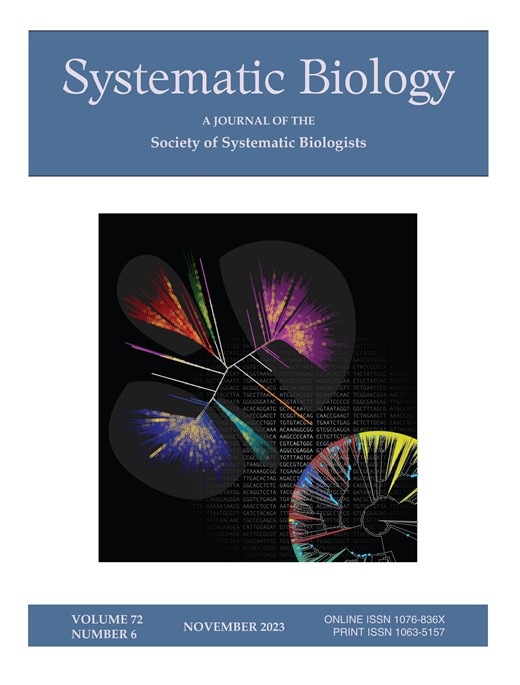整合基因组学,收集和社区科学来划定物种澄清可变巨蜥(Varanus tristis)的分类。
IF 5.7
1区 生物学
Q1 EVOLUTIONARY BIOLOGY
引用次数: 0
摘要
物种多样性的准确表征是生态和进化研究以及保护的重要前提。因此,有必要根据进化过程的推断产生强有力的物种极限假设。综合物种划界是基于多种证据来源对物种界限的推断,可以为物种多样性及其背后的过程提供独特的见解。在这里,我们展示了如何将社区观察与标准分子和表型数据集整合在一个综合框架下,以确定产生遗传和表型变异的过程。我们在Varanus tristis中实施了这种方法,Varanus tristis是一种分布广泛且多变的澳大利亚巨蜥复合体。利用基因组学、表型学(线性和几何形态计量学、颜色)、空间和环境数据,我们发现这种复合物的差异与种内变异不一致,而是表明物种形成已经发生。根据我们的研究结果,我们为这个复杂的物种提供了一个更新的分类,并确定了可能对变异的地理分类负责的过程。我们的工作流程为综合分析几种类型的数据提供了指导方针,以确定物种形成的发生和原因。此外,我们的研究强调了社区科学和机器学习(这里使用的两种工具)在分类学研究中的好处和警告。本文章由计算机程序翻译,如有差异,请以英文原文为准。
Integrating Genomics, Collections, and Community Science to Delimit Species Clarifies the Taxonomy of a Variable Monitor Lizard (Varanus tristis).
The accurate characterization of species diversity is a vital prerequisite for ecological and evolutionary research, as well as conservation. Thus, it is necessary to generate robust hypotheses of species limits based on the inference of evolutionary processes. Integrative species delimitation, the inference of species limits based on multiple sources of evidence, can provide unique insight into species diversity and the processes behind it. Here, we show how community observations can be integrated with standard molecular and phenotypic datasets under an integrative framework to identify the processes generating genetic and phenotypic variation. We implement this approach in Varanus tristis, a widespread and variable complex of Australian monitor lizards. Using genomic, phenotypic (linear and geometric morphometrics, coloration), spatial, and environmental data, we show that disparity in this complex is inconsistent with intraspecific variation and instead suggests that speciation has occurred. Based on our results, we provide an updated taxonomy for this complex and identify the processes that may have been responsible for the geographic sorting of variation. Our workflow provides a guideline for the integrative analysis of several types of data to identify the occurrence and causes of speciation. Furthermore, our study highlights the benefits and caveats associated with community science and machine learning-two tools used here-in taxonomic research.
求助全文
通过发布文献求助,成功后即可免费获取论文全文。
去求助
来源期刊

Systematic Biology
生物-进化生物学
CiteScore
13.00
自引率
7.70%
发文量
70
审稿时长
6-12 weeks
期刊介绍:
Systematic Biology is the bimonthly journal of the Society of Systematic Biologists. Papers for the journal are original contributions to the theory, principles, and methods of systematics as well as phylogeny, evolution, morphology, biogeography, paleontology, genetics, and the classification of all living things. A Points of View section offers a forum for discussion, while book reviews and announcements of general interest are also featured.
 求助内容:
求助内容: 应助结果提醒方式:
应助结果提醒方式:


